GamesRadar+ Verdict
The Sinden Lightgun is by far the best way to play arcade shooters at home. Not only does it bridge the tech gap between your new monitor or TV and classic collection of action capers, but it feels more authentic than original console accessories. If you’ve been itching to play Time Crisis or House of the Dead in your living room, picking up this PC controller is a complete no-brainer.
Pros
- +
Excellent build quality
- +
Authentic light gun design
- +
No additional sensors required
- +
Brilliant optional recoil effects
Cons
- -
Some manual setup required
- -
Software may feel overwhelming
- -
White border will reduce screen size
Why you can trust GamesRadar+
I’ve tested loads of controllers in my life, but the Sinden Lightgun is the only one that has managed to hit me in the feels. Up until a few years ago, my local arcade still had an original Time Crisis 2 arcade machine, and while it was understandably battle worn, the nostalgia of gripping its sticky blue plastic firearm soothed my ageing soul with memories of better times. Sadly, the unit presumably went to the big amusement centre in the sky while I wasn’t looking, but I thankfully now have an authentic, easy way to honour its memory without dusting off old consoles and CRT TVs.
If you’ve ever tried to work out how to play retro games on a modern TV, chances are you’ve experienced issues when it comes to light guns. Simply put, old console peripherals like the Namco GunCon aren’t going to work on a modern display, as they use a sensor inside designed with CRTs in mind. That means you won’t be able to set up your OG PlayStation or Dreamcast and play using those old controllers, but the Sinden Light Gun was created to fill that specific gap.
The Sinden Lightgun starts at $104.99 / £84.99, which might sound like a lot for a PC controller made for a specific genre. However, this isn’t a peripheral made by a huge corporation, and the experience it provides goes above and beyond any other alternative. Rather than relying on sensor bars or cameras (looking at you, PS3 and Wii), the Sinden Light Gun instead finds ways to cleverly mimic the functionality of old accessories. In a blog post, creator Andy Sinden says the device “uses smart image recognition with some clever maths and clever software” to function just like the firearm you’d have used both at the arcade and at home. I’m thrilled to report that it makes good on its inventor’s promise, and I’m not as sad about my favorite local machine retiring as I would have been.
Design
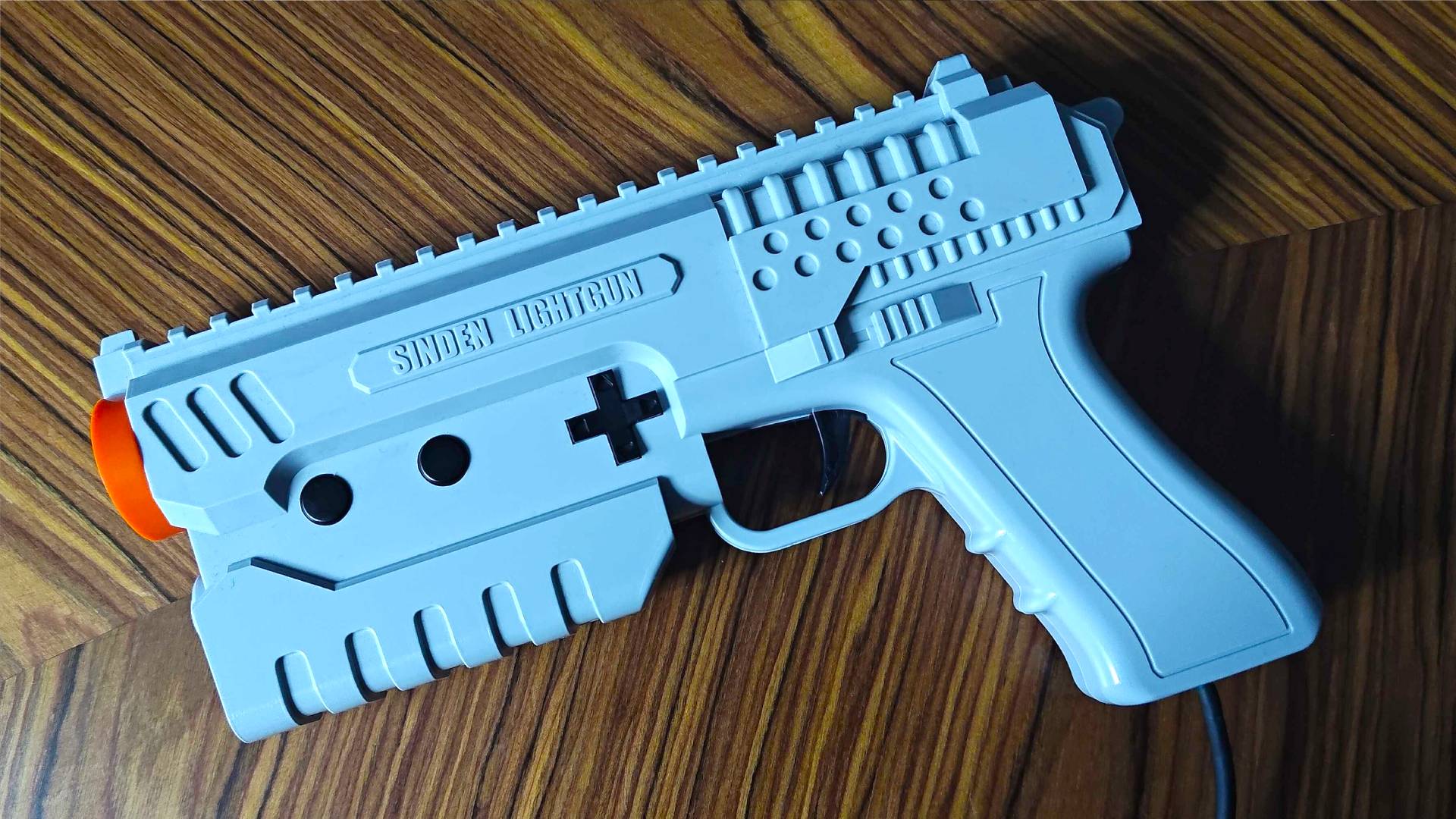
Before we delve into the Sinden Lightgun’s super powers, let’s chat a bit about its nostalgic good looks. Available in grey, red, blue, or black, the controller manages to blend the aesthetics of multiple iconic arcade light blasters into something entirely new, all while wearing all the buttons you’ll need to use it with a PC. Those buttons include a D-pad and four separate inputs at each side that are mapped to necessary functions, and a sliding reload bar at the bottom connected to a switch.
Despite its all-plastic construction, the Sinden Lightgun feels pretty weighty in the hand, but not so much so as to feel like a workout. Naturally, I don’t have an old House of the Dead arcade machine next to me for comparison, but my brain is telling me both guns feature the same amount of heft. That said, the controller I’m testing specifically is the one with recoil built in, so the vanilla model might be a tad lighter.
To comply with US law, the controller has an orange ring around the front of its barrel, but it actually slides off if you’re aiming for a more authentic arcade look. While staring down the barrel of the gun, you’ll notice something that looks like a webcam lurking within. Before your imagination gets the better of you, please note that this is actually part of the peripheral and not something the government has stashed within to spy on you. At least, that’s what I’m telling myself anyway.
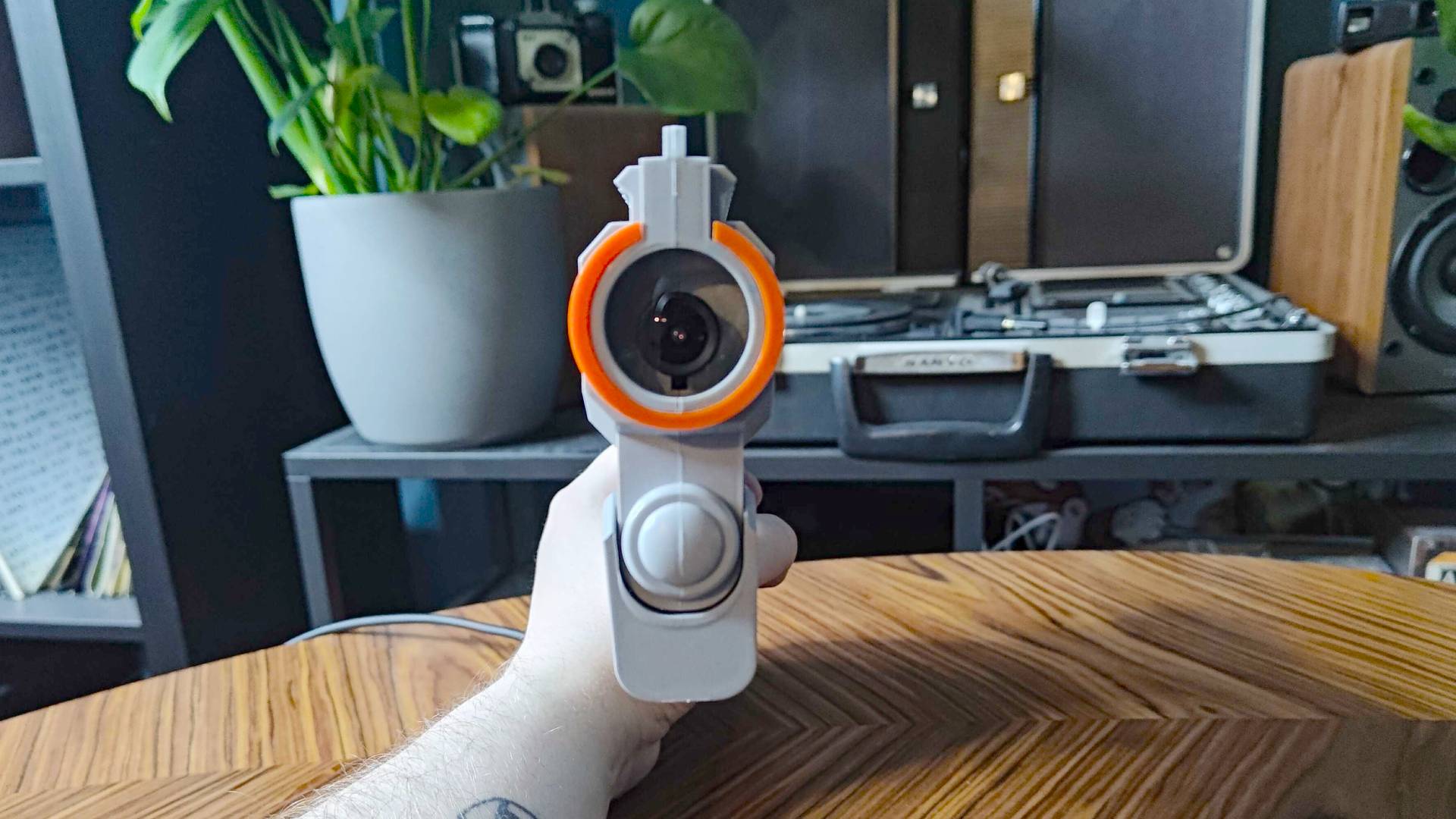
Features
To fully understand the features provided by the Sinden Lightgun, it’s worth briefly touching on how the controller actually works. Remember that camera mentioned above? According to the peripheral’s creator, that’s a high speed 60fps camera that’s designed to keep track of your screen. The device then emulates mouse clicks to transmit trigger shots as inputs, meaning as far as your PC is concerned, you’re using a regular old clicker. Don’t worry, though, the end result feels like anything but mouse emulation, and that “clever maths” at play feels almost like magic.
As with most great PC accessories, hardware is only half the story, and the Sinden Lightgun has a program that makes the magic happen. Admittedly, the software looks pretty antiquated, but while there’s an overwhelming number of options in the app, each section is clearly labelled. Plus, you might not actually have to mess around with as many settings as you’d think to get it up and running, as the hardware and drivers do a lot of the heavy lifting, at least when it comes to tricking Windows.
Under the hood functions aside, the Sinden app places a mandatory white border around your screen of choice, designed to help the gun detect boundaries. Without it, you’ll notice the sensor struggles to keep track of where the mouse is on screen, in turn causing a bit of a ruckus. Yes, the border does mean you’ll technically lose some screen space, but I personally don’t find it that intrusive, especially when applied to gaming monitors or large TVs with plenty of room to spare.
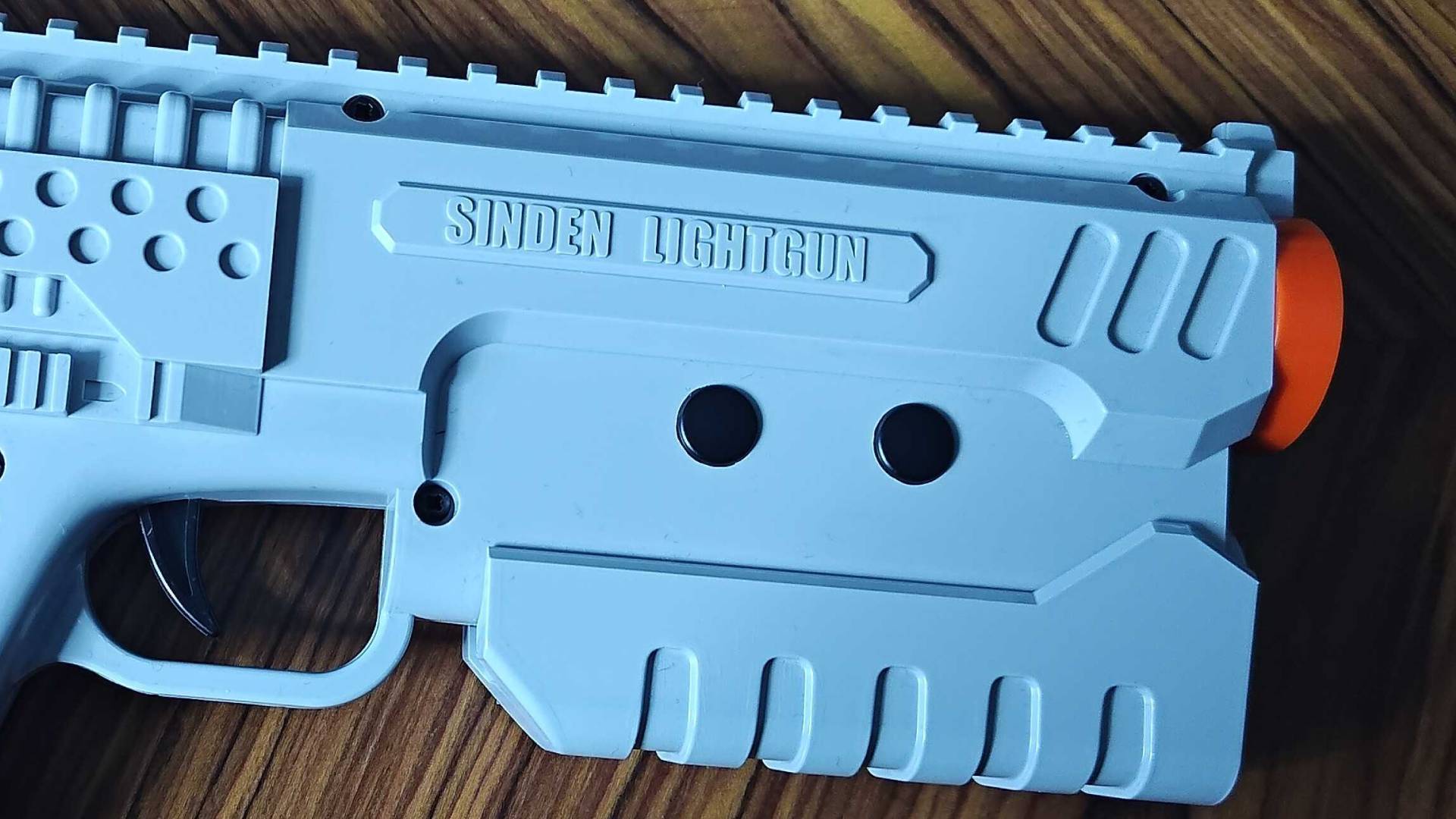
If you choose to go for the controller with recoil built in, your Sinden Lightgun will also come with a chonky solenoid hooked up to a circuit. The setup will provide that beautiful brap brap sound you’ll remember from the arcade, and its sheer volume initially caught me off guard. It’s probably not something you’ll want to use during sneaky midnight Time Crisis sessions, as your neighbours will probably get either concerned or irritated, but the feedback really helps place you back in your childhood sneakers.
Provided you’ve got the funds to go the extra mile, you’ll also be able to pick up extras like a specially made arcade pedal and even a holster. This is going to appeal most to those of you out there aiming to build something arcade-shaped rather than sitting on the couch, and at $249.99, I’d say the pedal really is aimed at enthusiasts. If you’re not really into DIY, Siden tech has also started making its way to pre-built setups by the likes of Arcade1Up, just in case you’ve got serious cash to spend on something for your fancy game room or bar area.
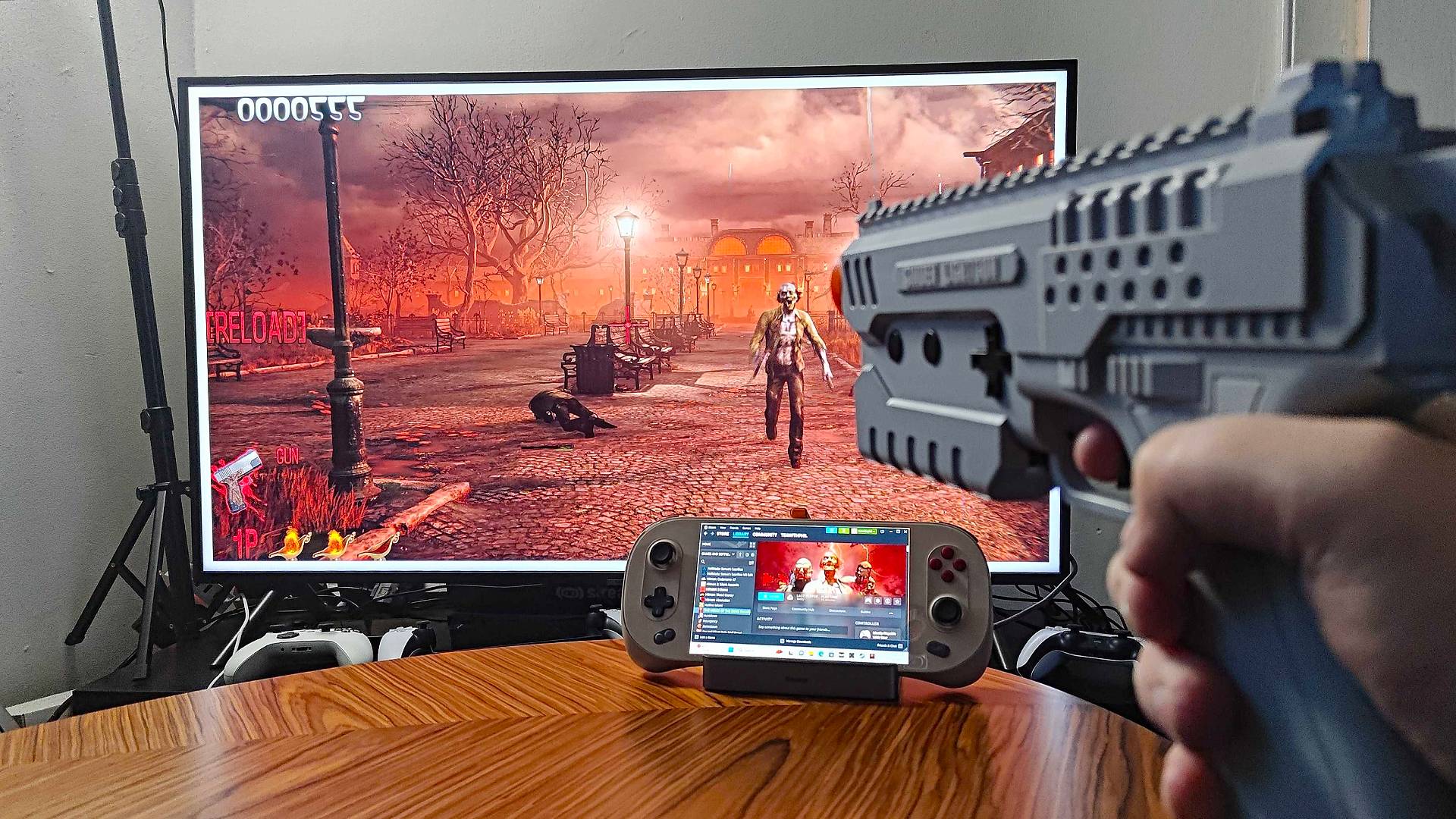
Performance
I’ve already covered how the Sinden Lightgun looks, feels, and what it brings to the table, but all that means nothing if it can’t, y’know, shoot things on a modern screen. So, to put the gaming PC glock to the test, I tried it out with a blend of modern PC releases and classics using emulation. I even decided to try setting it up on a gaming handheld, the Ayaneo 2S to be precise, just to see whether system specs would actually affect anything (spoiler, it doesn’t, and that’s absolutely rad).
Starting off with my modern collection of Steam light gun games, the process of getting set up was much simpler than I thought it’d be. All I effectively had to do was download the Sinden software, select my lightgun in the specific tab, and ‘hit start’. Pressing the second button on the right hand side automatically places that aforementioned white border round the edges, enabling you to actually use the gun as a mouse before you even launch the game. As far as I can tell, there isn’t a way to actually activate the controller using a button too, which would save you from having to initially click the app on screen, but that’s just a minor gripe.
Once up and running, I immediately dived into The House of the Dead Remake, a game I’ve been saving for this very moment. I was at least expecting some shenanigans to occur in terms of tracking, however, the gun instantly responded and sent virtual bullets through the heads of many an undead creep with remarkable accuracy. Feeling inspired, I decided to go revisit House of the Dead Overkill while I was at it, and not having to defend myself by typing words made for a refreshing change.
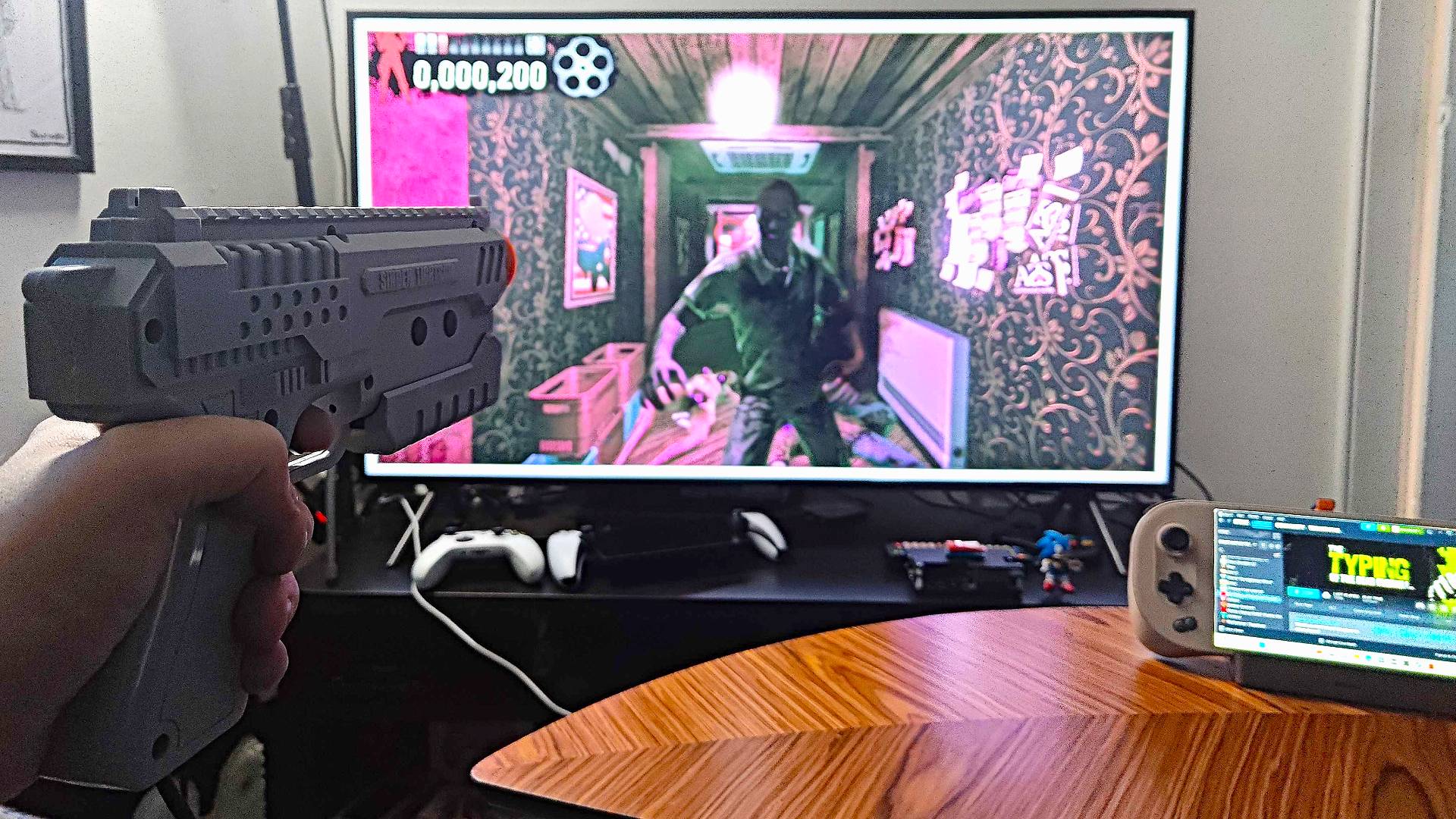

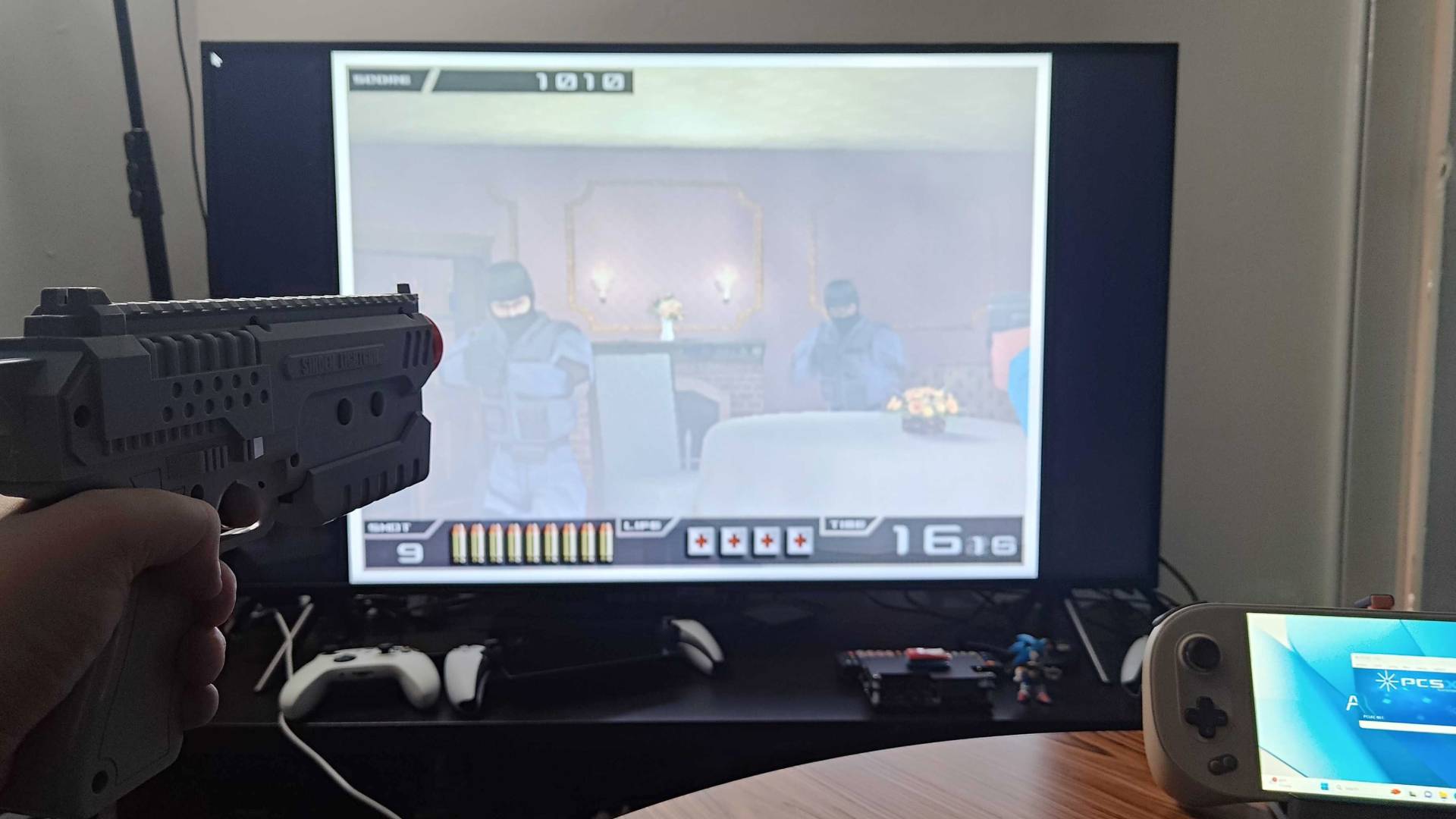
It’s frankly a crime that there aren’t more modern light gun games on Steam, and this is my call to developers out there to cook me up something new to play. Since there isn’t an abundance of comparative games around, I naturally fell back to old favorites within my physical collection using emulation. It’s worth noting that, if you’re savvy enough, there is a way to use the Sinden gun with original consoles using a dash of programming and an Arduino, but I’ll be sticking with PC-related shenanigans (for the time being).
So, onwards we march to the emulation portion of this review, and I decided to largely focus on using the Sinden Lightgun with PCSX2. To actually use the emulator with the controller, you’ll need to download and install a plugin named ‘Nuvee’, designed to turn your mouse into a makeshift light gun. Since the peripheral works in a similar way, it means it’ll allow it to act like an original GunCon in supported games. You’ll find more details about the plugin within this handy PCSX2 forum, and I wouldn’t have been able to try out Time Crisis 2 for the PS2 without it.
As for how the Sinden Lightgun ‘performs’ as a Guncon, I wasn’t expecting it to feel as authentic as it did. The initial calibration screen did give me a little bit of jittery bother initially, but I was able to remedy the issue by revisiting instructions relating to that previously mentioned Nuvee plugin. Once resolved, however, I ended up playing the clock-watching shooter sequel just like I would on an original PS2 with every shot landing true, and that felt pretty special.

Should you buy the Sinden Light Gun?
If you’re looking to play arcade shooters using a modern screen, the Sinden Lightgun is the solution you’re looking for. I’m under no illusions that this PC controller is best suited to those of you willing to dabble with emulation, and some of the extra setup steps could be considered off putting. The software also may rub some of you looking for a super user-friendly setup the wrong way, but if you stick with Steam games, you’ll be surprised how straight forward the setup process actually is.
Ultimately, the Sinden Lightgun is helping keep a dwindling genre alive by facilitating the right hardware. Don’t get me wrong, it’s hard to beat the warm glow of a CRT and messing around with old consoles, but like it or not, there will come a time when old tube TVs are no longer in service. Thanks to this ingenious invention, my living room retro arcade dreams are now a reality, and I reckon it could do the same for many of you if you are in the market for the same experience.
How I tested the Sinden Lightgun
For a couple of weeks, I pitched up an arcade setup using the Sinden Lightgun at my desk and living room. I tested the controller using both a 32-inch 4K monitor and a 50-inch TV, hooked up to my gaming PC and an Ayaneo 2S handheld respectively. I then used the peripheral to play Steam games like House of the Dead Remake and emulated classics like Time Crisis 2 while comparing the results to previous experiences using original hardware.
If you'd like to learn more about how we carry out our reviews, swing by our GamesRadar Hardware Policy to learn more about the whole process.
Looking for a big screen? Check out the best gaming TV models that'll pair perfectly with your console or PC.

Phil is the Hardware Editor at GamesRadar and joined the team in 2023. In the past, they've also contributed to the likes of TechRadar, The Daily Star, the BBC, and PCGamesN, but these days, they specialize in testing the latest gaming handhelds, monitors, TVs, and PC components. They're also extremely nerdy about retro consoles and playing the classics on both new and old systems.



